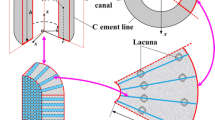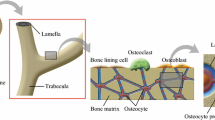Abstract
The effect of fluid flow on tissue adaptation was the focus of many research works during the last years. Moreover, the use of poroelasticity models to simulate and understand the interstitial flow movement has taken interest due to the possibility to include the fluid effect on mechanical simulations. In particular, shear stresses induced by bone canalicular fluid flow are suggested to be one of the mechanical stimulus controlling bone remodeling processes. Due to the high difficulty to measure canalicular fluid flow and shear stresses, computational poroelastic models can be used in order to estimate these parameters. In this work, a finite element dual porosity model based on Russian doll poroelasticity is developed. Two experiments with a turkey ulna and a human femur are simulated. Bone lacuno-canalicular fluid flow is computed and compared with the experimental results, focusing on the zones of bone remodeling and showing a relation between this flow and the bone formation process.
Similar content being viewed by others
References
Anderson, E.J., Kaliyamoorthy, S., Alexander, J.I.D., Knothe Tate, M.L.: Nano-microscale models of periosteocytic flow show differences in stresses imparted to cell body processes. Ann. Biomed. Eng. 33, 52–62 (2005)
Anderson, E.J., Knothe Tate, M.L.: Idealization of pericellular fluid space geometry and dimension results in a profound underprediction of nano-microscale stresses imparted by fluid drag on osteocytes. J. Biomech. 41, 1736–1746 (2008)
Bacabac, R.G., Smit, T.H., Mullender, M.G., Van Loon, J.J.W.A., Klein-Nulend, J.: Initial stress-kick is required for fluid shear stress-induced rate dependent activation bone cells. I. Ann. Biomed. Eng. 33, 104–110 (2005)
Beno, T., Yoon, Y., Cowin, S.C., Fritton, S.P.: Estimation of bone permeability using accurate microstructural measurements. J. Biomech. 39, 2378–2387 (2006)
Britz, H.M., Thomas, C.D.L., Clement, J.G., Cooper, D.M.: The relation of femoral osteon geometry to age, sex, height and weight. Bone 45(1), 77–83 (2009)
Burger, E.H., Klein-Nulend, J., Smit, T.H.: Strain-derived canalicular fluid flow regulates osteoclast activity in a remodelling osteon - a proposal. J. Biomech. 36, 1453–1459 (2003)
Cardoso, L., Fritton, S.P., Gailani, G., Benalla, M., Cowin, S.C.: Advances in assessment of bone porosity, permeability and interstitial fluid flow. J. Biomech. 46(2), 253–265 (2013)
Cowin, S.: Bone poroelasticity. J. Biomech. 32, 217–238 (1999)
Cowin, S.: Mechanosensation and fluid transport in living bone. J. Muskuloske Neuron. Interact. 2, 256–260 (2002)
Cowin, S.C., Cardoso, L.: Blood and interstitial flow in the hierarchical pore space architecture of bone tissue. J. Biomech. 48(5), 842–854 (2015)
Cowin, S.C., Gailani, G., Benalla, M.: Hierarchical poroelasticity: movement of interstitial fluid between porosity levels in bones. Philos. Trans. Royal Soc. A 367(1902), 3401–3444 (2009)
Cowin, S.C., Hegedus, D.H.: Bone remodeling I: theory of adaptive elasticity. J. Elast. 6(3), 313–326 (1976)
Fornells, P., García-Aznar, J.M., Doblaré, M.: A finite element dual porosity approach to model deformation-induced fluid flow in cortical bone. Ann. Biomed. Eng. 35, 1687–1698 (2007)
Fritton, S.P., Weinbaum, S.: Fluid and solute transport in bone: flow-induced mechanotransduction. Annu. Rev. Fluid Mech. 41(1), 347–374 (2009)
Gailani, G., Cowin, S.: Ramp loading in Russian doll poroelasticity. J. Mech. Phys. Solids 59(1), 103–120 (2011)
Gururaja, S., Kim, H.J., Swan, C.C., Brand, R.A., Lakes, R.S.: Modeling deformation-induced fluid flow in cortical bone’s canalicular-lacunar system. Ann. Biomed. Eng. 33, 7–25 (2005)
Harrigan, T.P., Hamilton, J.J.: Bone strain sensation via transmembrane potential changes in surface osteoblasts: loading rate and microstructural implications. J. Biomech. 26(2), 183–200 (1993)
Kumar, N.C., Dantzig, J., Jasiuk, I.: Modeling of cortical bone adaptation in a rat ulna: effect of frequency. Bone 50(3), 792–797 (2012)
Mak, A.F.T., Huang, D.T., Zhang, J.D., Tong, P.: Deformation induced hierarchical flows and drag forces in bone canaliculi and matrix microporosity. J. Biomech. 30, 11–18 (1997)
Pereira, A.F., Javaheri, B., Pitsillides, A.A., Shefelbine, S.J.: Predicting cortical bone adaptation to axial loading in the mouse tibia. J. Royal Soc. Interface 12(110), 20150590 (2015)
Pereira, A.F., Shefelbine, S.J.: The influence of load repetition in bone mechanotransduction using poroelastic finite-element models: the impact of permeability. Biomech. Model. Mechanobiol. 13(1), 215–225 (2014)
Qin, Y., Rubin, C.T., McLeod, K.J.: Nonlinear dependence of loading intensity and cycle number in the maintenance of bone mass and morphology. J. Orthop. Res. 16, 482–489 (1998)
Smit, T.H., Burger, E.H., Huyghe, J.M.: A case for strain-induced fluid flow as regulator of BMU-coupling and osteonal alignment. J. Bone Miner. Res. 17, 2021–2029 (2002)
Steck, R., Niederer, P., Knothe Tate, M.L.: A finite element analysis for the prediction of load-induced fluid flow and mechanochemical transduction in bone. J. Theor. Biol. 220, 249–259 (2003)
Wang, L., Fritton, S.P., Cowin, S.C., Weinbaum, S.: Fluid pressure relaxation depends upon osteon microstructure: modelling an oscillatory bending experiment. J. Biomech. 32, 663–672 (1999)
Weinbaum, S., Cowin, S., Zeng, Y.: A model for the excitation of osteocytes by mechanical loading-induced bone fluid shear stresses. J. Biomech. 27(3), 339–360 (1994)
Wolff, J.: Das Gesetz Der Transformation Der Knochen. Hirschwald, Berlin (1892)
Zhang, D., Weinbaum, S., Cowin, S.C.: Estimates of the peak pressures in bone pore water. J. Biomech. Eng. 120, 697–703 (1998)
Funding
This study is supported by the Spanish Ministry of Economy and Competitiveness throug research projects DPI2017-84780-C2-1-R, and RTI2018-094494-B393C21, and by Aragón Government (T50_17R).
Author information
Authors and Affiliations
Corresponding author
Additional information
Publisher’s note
Springer Nature remains neutral with regard to jurisdictional claims in published maps and institutional affiliations.
Rights and permissions
About this article
Cite this article
Sánchez, M.T., Pérez, M.Á. & García-Aznar, J.M. The role of fluid flow on bone mechanobiology: mathematical modeling and simulation. Comput Geosci 25, 823–830 (2021). https://doi.org/10.1007/s10596-020-09945-6
Received:
Accepted:
Published:
Issue Date:
DOI: https://doi.org/10.1007/s10596-020-09945-6




